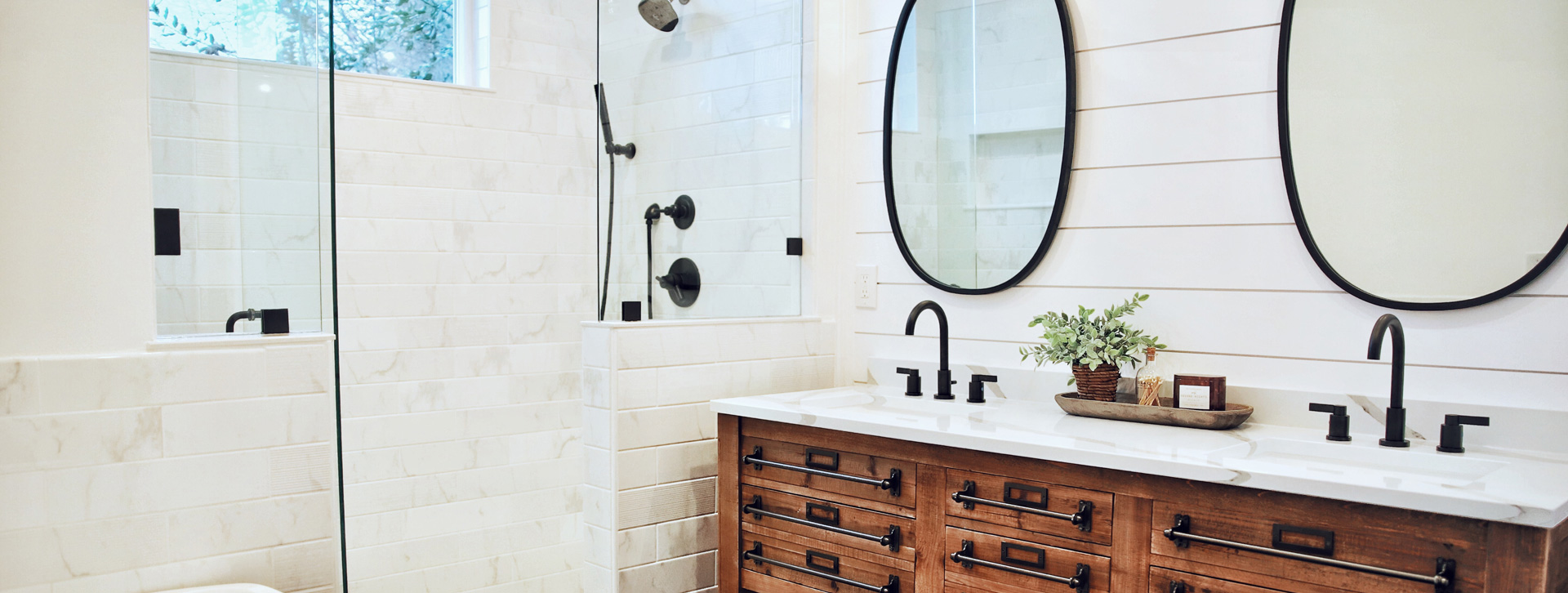Planning and Preparation: Steps To Redo Bathroom

Embarking on a bathroom renovation is an exciting endeavor, but like any construction project, it requires meticulous planning and preparation to ensure a smooth and successful outcome. A well-defined budget and timeline are essential for staying on track and preventing unexpected financial burdens.
Budgeting and Timeline
A detailed budget helps in allocating funds efficiently for materials, labor, permits, and unforeseen expenses. It is essential to research costs for various materials, fixtures, and appliances to estimate the overall project expense. Creating a realistic timeline with milestones and deadlines allows you to track progress and stay organized. Consider factors like availability of materials, contractor schedules, and potential delays when establishing the timeline.
Planning the Scope of Work
Before diving into the renovation, it’s crucial to define the scope of work clearly. Consider the desired aesthetic, functionality, and features of the new bathroom. This includes decisions about layout, flooring, fixtures, lighting, and storage solutions. A detailed plan helps visualize the final outcome and ensures that all necessary elements are incorporated.
Gathering Tools and Equipment
Renovating a bathroom involves a range of tasks, requiring various tools and equipment. A comprehensive checklist helps ensure that you have all the necessary tools for each stage of the project. Here is a list of essential tools and equipment:
- Measuring tape
- Level
- Hammer
- Screwdrivers (Phillips and flathead)
- Pliers
- Wrench set
- Utility knife
- Safety glasses
- Work gloves
- Dust mask
- Ear protection
Managing the Project Efficiently
Breaking down the project into manageable tasks helps to avoid feeling overwhelmed and ensures a systematic approach. Create a task list with estimated timeframes for each step. Prioritize tasks based on their importance and dependencies. Regularly review progress and make adjustments to the plan as needed. Effective communication with contractors and suppliers is essential for timely completion and coordination.
Demolition and Removal

Demolition and removal are the exciting, albeit messy, stages of a bathroom remodel. This is where you finally get to see your old bathroom disappear and make way for your new design. However, it’s important to approach this stage with a plan and safety in mind.
Removing Existing Fixtures
Removing fixtures like the toilet, sink, and bathtub requires a methodical approach to ensure safety and minimize damage to surrounding areas.
- Toilet: Turn off the water supply to the toilet, flush the tank to empty it, and disconnect the water supply line. Then, detach the toilet from the floor by loosening the bolts that hold it in place.
- Sink: Turn off the water supply to the sink and drain the pipes. Disconnect the drain pipe and the water supply lines. Unscrew the sink from the countertop and remove the mounting hardware.
- Bathtub: Disconnect the water supply lines and drain the tub. Carefully detach the tub from the surrounding walls and floor using a pry bar or similar tool. Be mindful of potential damage to the surrounding surfaces.
Dismantling Outdated Tile, Flooring, and Cabinetry
This step involves removing old tile, flooring, and cabinetry to prepare for the new installation.
- Tile: Use a hammer and chisel to carefully remove the tile, starting from the edges. Wear protective gear like safety glasses and gloves.
- Flooring: Depending on the type of flooring, you might need specialized tools. For example, you’ll need a pry bar to remove vinyl flooring and a saw for wood flooring.
- Cabinetry: Remove any screws or nails that hold the cabinets in place. Carefully detach the cabinets from the walls and dispose of them properly.
Proper Disposal of Hazardous Materials
It’s crucial to dispose of hazardous materials like asbestos safely.
- Asbestos: If you suspect your bathroom contains asbestos, do not attempt to remove it yourself. Contact a professional asbestos removal company to ensure proper handling and disposal.
Protecting Surrounding Areas from Dust and Debris
Demolition generates a significant amount of dust and debris, so it’s essential to protect surrounding areas.
- Covering: Cover furniture and appliances in adjacent rooms with plastic sheeting or drop cloths to prevent dust accumulation.
- Air Filtration: Use a HEPA air filter to capture dust particles and improve air quality.
- Clean-up: Regularly sweep and vacuum the area to remove dust and debris as you work.
Installation and Finishing

The demolition and removal phase is complete, and the bathroom is ready for its transformation. Now comes the exciting part – installing the new fixtures, laying the tiles, and putting the finishing touches to create your dream bathroom.
Installing Plumbing Fixtures, Steps to redo bathroom
Installing plumbing fixtures requires precision and attention to detail. This process involves connecting the fixtures to the water supply and drainage system.
- Toilet Installation: Begin by attaching the toilet to the floor using the provided bolts and a wax ring. Connect the toilet to the water supply line and the drain pipe. Ensure the toilet is level and secure.
- Sink Installation: Mount the sink to the countertop or vanity using the appropriate hardware. Connect the sink to the water supply lines and the drain pipe. Ensure the faucet is properly installed and the drain is secure.
- Shower Installation: Install the shower pan and connect it to the drain pipe. Attach the shower head and shower arm to the plumbing lines. Ensure the shower valve is properly installed and the shower stall is watertight.
Laying Tile and Flooring
Laying tile and flooring is a meticulous process that requires careful planning and execution. This involves preparing the subfloor, applying adhesive, and setting the tiles or flooring.
- Tile Installation: Before laying tiles, ensure the subfloor is level and smooth. Apply a thin layer of adhesive to the subfloor and carefully place the tiles. Use spacers to maintain even grout lines. Allow the adhesive to cure completely before grouting.
- Flooring Installation: The process for installing flooring varies depending on the type of flooring you choose. Some flooring types require a subfloor preparation, while others can be installed directly over the existing subfloor. Consult the manufacturer’s instructions for specific installation guidelines.
Installing Cabinetry
Installing new cabinetry adds functionality and style to your bathroom. This involves assembling the cabinets, mounting them to the walls, and installing the doors and hardware.
- Cabinet Assembly: Follow the manufacturer’s instructions to assemble the cabinets. Ensure all components are properly connected and secured.
- Cabinet Installation: Use a level to ensure the cabinets are installed straight and plumb. Secure the cabinets to the wall using appropriate hardware. Install the doors and hardware, ensuring they operate smoothly.
Applying Sealant, Grout, and Paint
Applying sealant, grout, and paint adds the final touches to your bathroom renovation. These materials create a finished look and protect the surfaces from moisture and wear.
- Sealant Application: Apply sealant to all joints and seams to prevent water damage. Allow the sealant to cure completely before using the bathroom.
- Grout Application: Apply grout to the spaces between the tiles, using a grout float to spread it evenly. Wipe away excess grout and allow it to cure completely before sealing.
- Paint Application: Apply paint to the walls and ceiling, using a roller or brush to ensure even coverage. Allow the paint to dry completely before applying a second coat, if necessary.
Ensuring Proper Ventilation and Lighting
Ventilation and lighting are crucial for creating a comfortable and functional bathroom. Proper ventilation prevents moisture buildup, while adequate lighting enhances the space.
- Ventilation: Install an exhaust fan to remove moisture and odors from the bathroom. Ensure the fan is properly vented to the exterior of the house.
- Lighting: Install sufficient lighting to illuminate the entire bathroom, including the vanity area, shower stall, and toilet. Consider using a combination of overhead and task lighting to create a balanced lighting scheme.
Steps to redo bathroom – Redoing your bathroom can be a fun project, but don’t forget about those hidden issues! If you’ve got an upstairs bathroom leaking through the ceiling, like the one described in this article upstairs bathroom leaking through ceiling , you’ll need to tackle that first.
Once you’ve fixed the leak, you can move on to those fun bathroom upgrades!
Redoing your bathroom? Don’t forget the windows! A fresh coat of paint and new tier bathroom window curtains can instantly elevate the space. Think about the overall vibe you’re going for – modern, rustic, or something in between. Once you’ve got the curtains sorted, you can move on to the rest of the bathroom makeover!